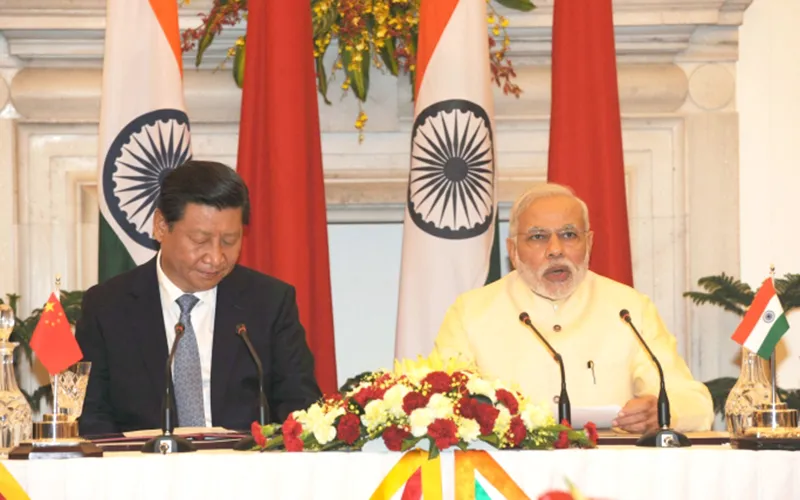-
CENTRES
Progammes & Centres
Location
As Xi and Modi meet in first Ahmedabad and then in New Delhi, India has political and strategic issues that it will want China to respond to - the contested border and territorial issues, China-Pakistan cooperation on nuclear, missile, maritime and border infrastructure issues.

Chinese President Xi Jinping's visit to India has garnered significant interest in the Indian media, though opinions are divided as to the likely outcome of the visit. Going by the recent visits of Chinese leaders, Xi is likely to focus much more on engaging India on the economic front rather than attempt to resolve the political problems between the two sides.
The new Indian leadership under Prime Minister Narendra Modi, who is also focused on economic matters, will also use the opportunity for seeking investments in India's infrastructure sector including ports and railways. China is keen to get a major role in the development of India's ports and India's river-linking projects, something the Modi Government is keen to push as part of his economic agenda. India's railway system remains antiquated and it too needs upgrading. India has added just about 164 kms of railway track per year on average.
China is also seeking to compete with Japan in offering its expertise in high-speed train service, suggesting that it can give much cheaper options than others, including Japan. But New Delhi remains somewhat wary of involving China in areas which have strategic importance, such as railways. In addition, India's previous experience with China in the power sector is a cause for concern for both because of quality issues and complaints from India's domestic industry.
Even as Modi looks to attract investment, he is likely to raise some of the tricky issues in the otherwise prospering India-China economic relations, such as India's market access in China and the trade imbalance that has risen to around US $40 bn. Market access in the areas of IT and pharmaceuticals has yet to be addressed by China in a satisfactory manner despite the Indian leadership taking this up for the last several years. The trade imbalance with China has also had the effect of creating dependencies on China that need to be rectified. India being a large market should be able to exercise some leverage and create counter-dependencies. The Sino-Japanese rare earth export spat in 2010 has caused some concerns in New Delhi about China's trade practices.
India also has political and strategic issues that it will want China to respond to - the contested border and territorial issues, China-Pakistan cooperation on nuclear, missile, maritime and border infrastructure issues and China's rising profile in the Indian Ocean region being some of these. On the border issues, both sides are taking a business as usual approach suggesting that incursions and transgressions are likely to occur when there is no clarity on the Line of Actual Control (LAC), but the rising military posture on both sides of the border increases the risks of inadvertent conflict. Also China's continuing stance on the stapled visa is seen as a reflection of its quest to question India's territorial integrity.
China feels that above issues can be resolved by future generations because it may be genuinely concerned that difficult talks on the border and territorial issues could hamper the progress on the economic front. For India, the continuing Chinese policy of military intrusions and stapled visa will continue to deepen the prevailing mistrust. Therefore, it is critical that the political leadership in both countries address this on a priority basis than sweep it under the carpet in favour of booming trade ties.
India also has no choice but to recognise the security implications of the China-Pakistan cooperation across the military and strategic front. The Chinese transfer of critical technologies in the past has altered the strategic and military balance in the region. China's foray into the Indian Ocean and its new maritime silk route objectives are pointers to its growing ambition in the region.
It is true that interests and influence of both India and China go beyond their immediate neighbourhood and there is every likelihood that the two countries will meet more often in contested spaces including international waters but a lot can be managed in a favourable manner if the two sides understand each other's rise as a reality. China appears to have some difficulty in accepting India as a rising power growing beyond its immediate South Asian neighbourhood. But the reality is that India cannot be confined to the South Asian region alone; even as India struggles internally on multiple fronts, its importance in the international realm is rising, a reality that China needs to accept.
Lastly, India needs to get a fix on what it expects from China in this relationship. For one, India-China relations should be not seen in a bilateral context alone; the broader strategic context and what happens there matter a lot to both.
(The writer is a Senior Fellow at Observer Research Foundation, Delhi. She served at the National Security Council Secretariat, Government of India from 2003 to 2007.)
The views expressed above belong to the author(s). ORF research and analyses now available on Telegram! Click here to access our curated content — blogs, longforms and interviews.

Dr Rajeswari (Raji) Pillai Rajagopalan was the Director of the Centre for Security, Strategy and Technology (CSST) at the Observer Research Foundation, New Delhi. Dr ...
Read More +